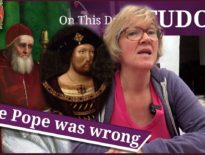On this day in history, 6th April 1621, in the Stuart period, Edward Seymour, 1st Earl of Hertford, died at Netley in Hampshire. He was aged around 81 at his death.
Now, Hertford is known for his secret marriage to Lady Katherine Grey, sister of Lady Jane Grey, and their conjugal visits in the Tower of London, but Hertford had a thing for secret marriage and married twice more, all in secret. And then his son and grandson also had secret marriages!
Find out more in today's talk.
Also on this day in Tudor history, 6th April 1590, Queen Elizabeth I’s diplomat, secretary, adviser and spymaster, Sir Francis Walsingham, died. Find out more about the man Elizabeth called her “moor” in last year’s video:
Also on this day in history:
- 1523 – Death of Henry Stafford, Earl of Wiltshire. Stafford had served Henry VII and was made a Knight of the Garter in his reign, and although he was imprisoned for a time due to his brother's plotting, he was a favourite of Henry VIII.
- 1523 – Death of Edward Stanley, 1st Baron Monteagle, soldier, peer and Knight of the Garter, at Hornby Castle.
- 1593 – Hanging of Henry Barrow and John Greenwood, religious separatists, after being condemned to death on 23rd March, for writing and publishing seditious literature.
- 1582 – Hanging of Nicholas Nugent, Solicitor General for Ireland, Baron of the Irish Court of Exchequer, and Chief Justice of the Irish Common Pleas, for treason after being implicated in the rebellion of his nephew, William Nugent.
- 1605 (5th or 6th) – Death of John Stow, historian and antiquary, in London at the age of eighty. He was buried in St Andrew Undershaft Church. Stow's works included his 1561 “The woorkes of Geffrey Chaucer, newly printed with divers additions whiche were never in printe before”, the 1565 “Summarie of Englyshe Chronicles” and his famous “Annales, or a Generale Chronicle of England from Brute until the present yeare of Christ 1580”.
Transcript:
On this day in history, 6th April 1621, in the Stuart period, Edward Seymour, 1st Earl of Hertford, died at Netley in Hampshire. He was about 81 at his death. He was laid to rest in Salisbury Cathedral.
Hertford is known for secretly marrying Lady Katherine Grey, sister of Lady Jane Grey and a claimant to the throne, in 1560, something which led to them both being thrown into the Tower of London. But after Katherine’s death, Hertford went on to marry twice more, both in secret.
Let me tell you more about this Tudor man…
• Edward was born in around 1539 and was the son and heir of Edward Seymour, Duke of Somerset, and his second wife, Anne Stanhope. His father had two sons by his previous marriage, but he’d repudiated his wife, Catherine Filliol, and their sons had been disinherited.
• Edward’s father served as Lord Protector in Edward VI’s reign until he was brought down and executed. His father’s lands and titles were declared forfeit. Edward was made a ward of the crown until his mother was released from the Tower in Mary I’s reign.
• When Elizabeth I came to the throne, Edward’s father’s lands were restored to him and he was made Baron Beauchamp and Earl of Hertford.
• In late 1560, Hertford secretly married Lady Katherine Grey, daughter of Queen Elizabeth I’s cousin, Frances Grey, Duchess of Suffolk, and a girl who was an heir to the throne. Hertford was recalled from a diplomatic mission to France in August 1561 because his pregnant wife had confessed her secret marriage to the queen’s favourite, Robert Dudley. The couple were imprisoned in the Tower of London, where, on 24th September 1561, Katherine gave birth to their son, also named Edward. The marriage was ruled invalid by an ecclesiastical high commission in May 1562, making little Edward illegitimate.
• Sir Edward Warner, Lieutenant of the Tower allowed the couple conjugal visits and Katherine went on to give birth to another son, Thomas, in February1563. Hertford was fined £15,000 for this.
• Following the birth of his second son, Hertford was prevented from seeing Katherine, and they never saw each other again. Katherine was eventually released from the Tower, but into house arrest, and she died in 1568.
• Hertford was released from the Tower in August 1563, but into the custody of his mother, Anne, and her second husband, Francis Newdigate, at their home at Hanworth. He ended up in the Tower once again, albeit temporarily, after his stepfather was implicated in helping John Hales, who wrote a pamphlet defending Hertford’s wife’s claim to the throne.
• In 1571, Hertford was allowed back at court and it was there that he met the woman who’d become his second wife, Frances Howard, a gentlewoman of Elizabeth I's Privy Chamber and daughter of Lord William Howard of Effingham. It is not known when they actually got married, but John Dee called her the Countess of Hertford in 1578. The queen gave her permission for the marriage in 1585.
• In 1581, his eldest son, Edward, Lord Beauchamp, secretly married Honora Rogers, and Hertford rather hypocritically would not accept the marriage and actually had his son taken into custody at Hertford House. Queen Elizabeth I and her council, however, sided with Beauchamp and Honora, and Hertford was forced into accepting his son’s marriage.
• In 1591, Queen Elizabeth I visited Hertford and his wife at heir home, Elvetham, in Hampshire.
• In late 1595/early 1596, Hertford ended up in the Tower once more for a couple of months after he supported his younger son Thomas’s appeal against the ruling that had deemed his parents’ marriage invalid.
• In 1598, Hertford’s second wife, Frances, died. Their marriage had been childless.
• In 1601, Hertford married Frances, daughter of Thomas, first Viscount Howard of Bindon. She was the wealthy widow of Henry Prannell and was twenty-two years of age when she married Hertford, who was in his early sixties. The couple married in secret at Hertford House. The marriage was childless.
• On the death of Elizabeth I in 1603, Hertford supported the claim of King James VI of Scotland, rather than promoting the claim of his eldest son, Edward, Lord Beauchamp, and he went on to gain favour in James I’s reign, serving as an ambassador and high steward of Queen Anne’s revenues.
• King James I visited Hertford at Tottenham Lodge, in Wiltshire, in 1603, 1617 and 1620.
• In 1608, King James gave Hertford’s son, Edward, the right to inherit the earldom of Hertford. He was still deemed as illegitimate, though.
• In 1610, Hertford’s grandson, William, secretly married Lady Arabella Stuart, daughter of Charles Stuart, Earl of Lennox, and Elizabeth Cavendish. Both William and Arabella were claimants to the throne and their marriage led to them being imprisoned. William escaped and fled abroad, but Arabella remained in the Tower, where she died in 1615.
• Although Hertford was angry with his grandson, he did give him an annual allowance while he was abroad. In 1612, William became Hertford’s heir after the death of his father, Beauchamp.
• Hertford acted as a patron of the Arts, and also had a company of players.
• He died on this day in 1621. Hertford’s grandson, William, had the remains of his grandmother, Lady Katherine Grey, moved from her resting place at Yoxford in Suffolk to Salisbury to be buried with Hertford in Salisbury Cathedral, and their tomb can still be seen there today in the south aisle. Katherine’s effigy is placed higher than that of her husband to reflect her royal status.
An inscription in Latin translates to:
“Incomparable Consorts
Who, experienced in the vicissitudes of changing fortune
At length, in the concord which marked their lives,
Here rest together.”



Leave a Reply